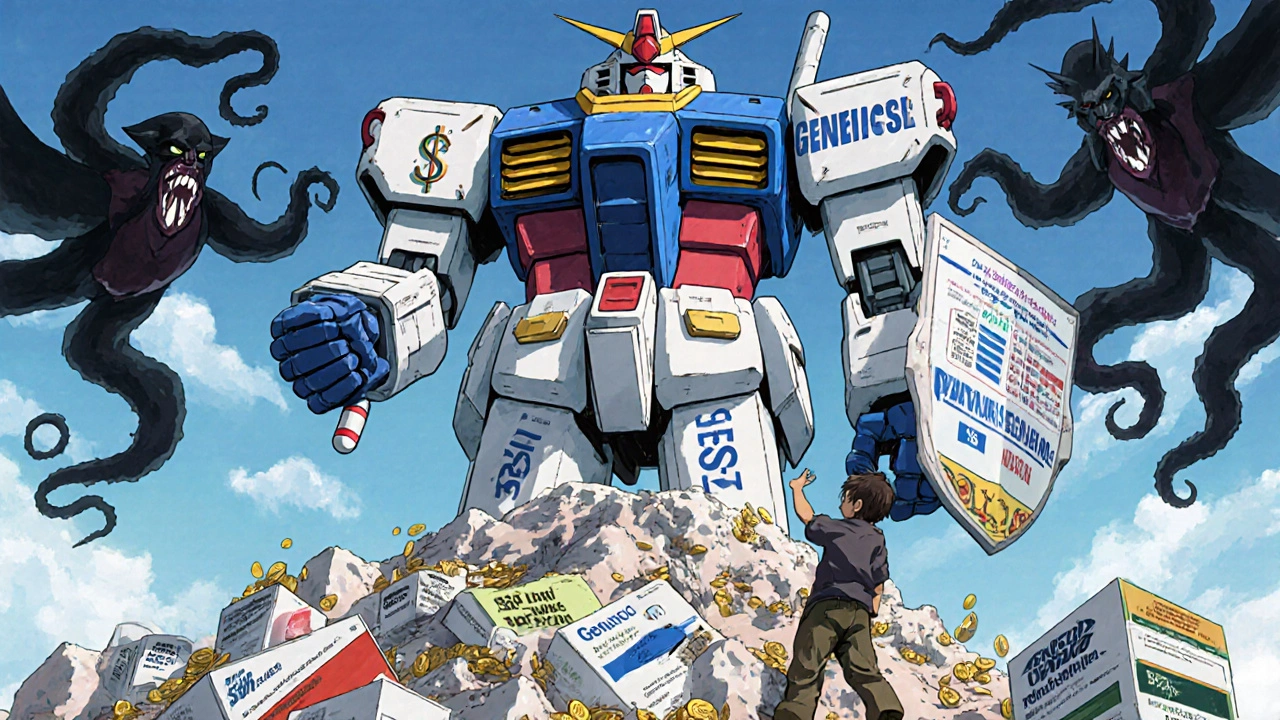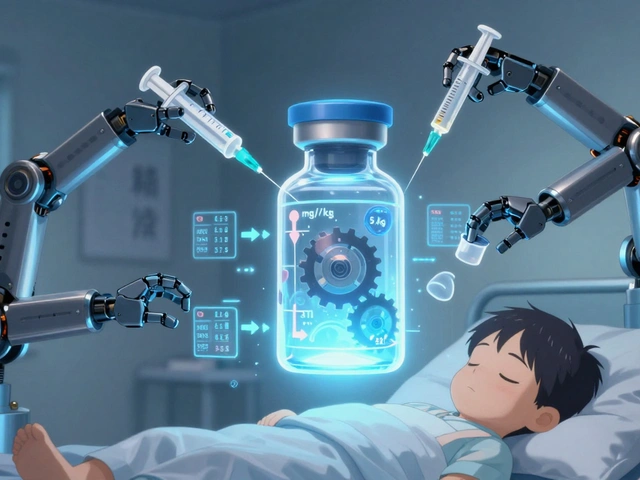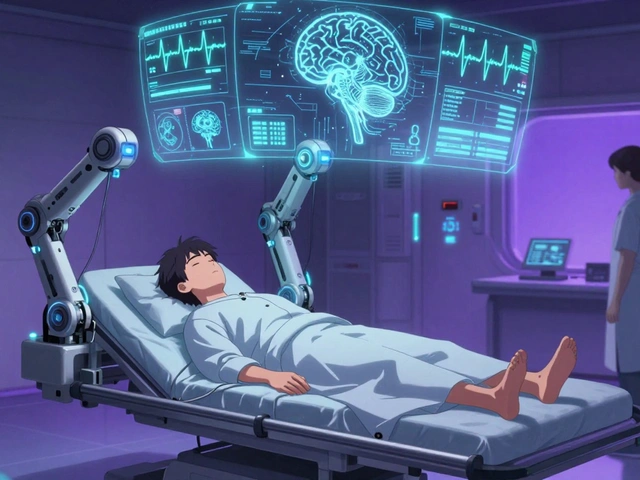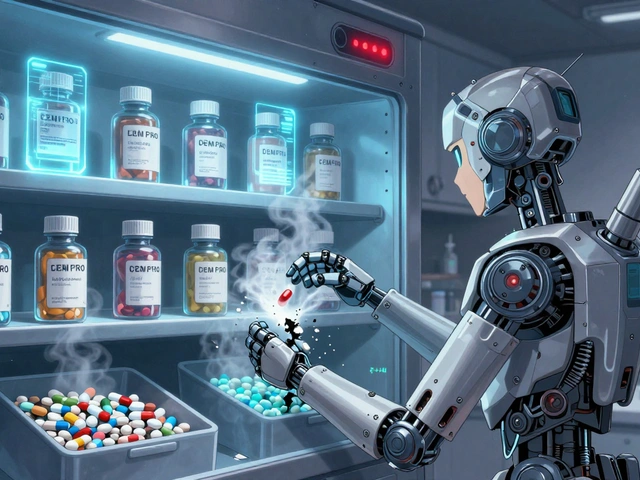For millions of low-income Americans, getting medicine shouldn’t mean choosing between rent and refills. That’s where Medicaid generics come in - they’re not just cheaper, they’re the reason so many people can actually afford to take their prescriptions every month.
In 2023, over 90% of all prescriptions filled through Medicaid were for generic drugs. That’s not a coincidence. It’s by design. Generic medications work the same way as brand-name drugs - same active ingredients, same effectiveness, same safety standards. But they cost a fraction of the price. And for people living paycheck to paycheck, that difference isn’t just nice to have - it’s life-changing.
How Much Do Generics Actually Save?
The numbers speak for themselves. In 2023, the average copay for a generic drug under Medicaid was $6.16. For a brand-name drug? $56.12. That’s nearly nine times more. For someone on a fixed income, that’s not a small difference. It’s the difference between filling a prescription and skipping it.
And it’s not just about what patients pay at the counter. The entire Medicaid system saves billions because of generics. In 2023, Medicaid rebates cut gross drug spending by $53.7 billion - more than half of what was originally spent. That’s because federal law requires drug makers to give Medicaid deep discounts. For non-specialty generics, the average rebate is 86% of the retail price. That means if a generic drug costs $100 on the shelf, Medicaid pays just $14 after the rebate.
Compare that to private insurance. Even with insurance, many people pay $30, $40, or more for the same generic drug. Medicaid’s pricing structure is one of the most effective in the country. In fact, a 2021 Congressional Budget Office study found Medicaid gets lower net prices than even the Department of Veterans Affairs.
Why Generics Are the Backbone of Medicaid
Medicaid doesn’t just use generics - it relies on them. About 90-91% of all prescriptions are for generics. Yet those same generics make up only 17.5% of total Medicaid drug spending. That’s the power of scale and negotiation. A handful of companies - Teva, Viatris, Sandoz - produce most of these drugs. They compete on price, and Medicaid uses that competition to drive costs down.
Because of this, 93% of generic prescriptions cost less than $20 at the pharmacy. That’s far higher than the 59% of brand-name drugs that fall under that threshold. For a parent managing asthma, diabetes, or high blood pressure, that means fewer trips to the pharmacy skipped, fewer missed doses, and better health outcomes.
Studies show that when out-of-pocket costs drop, people take their medicine more consistently. From 2009 to 2019, generic drugs saved the U.S. healthcare system $2.2 trillion. That’s not just a statistic - it’s millions of people avoiding hospital visits, ER trips, and complications because they could afford their pills.
The Hidden Costs: PBMs and Copay Surprises
But it’s not all smooth sailing. While Medicaid’s system is built to save money, there are leaks in the pipeline.
Pharmacy Benefit Managers (PBMs) - the middlemen between drug makers, pharmacies, and Medicaid - take a cut. In Ohio, a 2025 audit found PBMs collected 31% in fees on $208 million worth of generic drugs in just one year. That’s $64 million that could’ve gone back into lowering patient costs or expanding coverage.
And sometimes, even when the price of a generic drops, the patient’s copay doesn’t. Some states have fixed copay tiers that don’t adjust when drug prices fall. A patient might pay $10 for a generic that now costs $3 to make - and they’re still stuck with the same fee. That’s not savings. That’s a broken system.
Reddit threads from Medicaid users tell the real story. One mother wrote: “My daughter’s asthma inhaler switched to generic - my copay dropped from $25 to $3. But getting approval took three weeks. I called five times.” Prior authorization rules, meant to prevent waste, often become barriers. About 15-20% of Medicaid prescriptions require this step, and delays can mean missed doses or worsening conditions.

What About High-Cost Drugs?
Here’s the catch: generics are saving money on most prescriptions, but they’re not fixing the biggest problem.
Drugs that cost more than $1,000 per claim - like specialty treatments for cancer, hepatitis C, or rare diseases - make up less than 2% of Medicaid prescriptions. But they account for over half of all drug spending. In 2021, Medicaid spent $80.6 billion on prescriptions and collected $42.5 billion in rebates. Net spending was $38.1 billion. By 2024, that net number jumped to $60 billion - a $10 billion increase in just two years.
That’s why the Centers for Medicare & Medicaid Services (CMS) launched the GENEROUS Model in 2024. It’s a new program focused on reducing costs by better managing which drugs are covered, how they’re prescribed, and how rebates are negotiated. It’s not a fix-all, but it’s a step toward stopping the bleeding.
Experts warn that without action, Medicaid’s pharmacy budget could keep growing even as generic use stays strong. The future may lie in biosimilars - cheaper versions of biologic drugs - which could save up to $100 billion a year by 2027. But those aren’t widely available yet.
What Low-Income Patients Need to Know
If you’re on Medicaid, here’s what actually matters:
- Generics are your best friend. Always ask if a generic version is available - even if your doctor didn’t suggest it.
- Your copay is usually $5-$10 for generics. If it’s higher, ask why. It might be a state policy quirk.
- Prior authorization can delay care. Keep records of every call and denial. You have rights to appeal.
- Every state runs Medicaid differently. Some use managed care plans, others are fee-for-service. Know which one you’re in.
- Don’t assume brand-name is better. Generics are required by law to be just as effective.
Most patients don’t need to be experts. Pharmacies automatically substitute generics unless the doctor writes “dispense as written.” But if you’re unsure, ask. A simple question can save you $50 a month.

The Bigger Picture
Medicaid’s use of generics is one of the most successful cost-control strategies in U.S. healthcare. It’s not perfect. PBMs take too much. Copays don’t always reflect real prices. Specialty drugs are eating up savings.
But the core truth remains: without generics, millions of low-income Americans simply couldn’t afford their medicine. And that’s not just a policy win - it’s a human one.
The next time you hear someone say “generic drugs are inferior,” remember: for a single mom in Ohio, a $3 inhaler isn’t a compromise. It’s the only way her child can breathe.
Are generic drugs as safe and effective as brand-name drugs?
Yes. The FDA requires generic drugs to have the same active ingredients, strength, dosage form, and route of administration as the brand-name version. They must also meet the same strict standards for quality, purity, and performance. Studies show they work the same way in the body. The only differences are in inactive ingredients like fillers or colorants - which don’t affect how the drug works.
Why is my generic drug copay higher than expected?
Medicaid copays are set by your state, not by the actual drug price. Some states use fixed copay tiers that don’t change even if the drug’s cost drops. If you think your copay is too high, ask your pharmacy or Medicaid office for a breakdown. You may be able to appeal or switch to a different generic version with a lower copay.
Do all Medicaid programs cover the same generic drugs?
No. Each state has its own formulary - a list of covered drugs. While all states cover the most common generics, some may delay adding new ones or restrict access based on prior authorization. Check your state’s Medicaid website or call their pharmacy help line to see what’s covered. If a drug you need isn’t on the list, you can request an exception.
Can I save more by buying generics outside of Medicaid?
For most Medicaid patients, no. Programs like Mark Cuban Cost Plus Drug Company offer lower prices for uninsured people, but Medicaid’s negotiated rebates usually make generics cheaper than what you’d pay out-of-pocket. A 2023 study found that only 11.8% of generic prescriptions were cheaper through such services. Medicaid’s pricing is designed to be the most affordable option for enrolled patients.
What’s being done to lower Medicaid drug costs further?
The CMS launched the GENEROUS Model in 2024 to reduce spending through better formulary design and utilization controls. Experts also suggest extending Medicare’s new drug price negotiation rules to Medicaid, which could save $15-20 billion over ten years. Meanwhile, biosimilars - cheaper versions of expensive biologic drugs - are starting to enter the market and could add $100 billion in annual savings by 2027.
What Comes Next?
Medicaid’s success with generics proves that affordability and access can go hand-in-hand. But the system is under pressure. As new high-cost drugs enter the market, savings from generics are being eaten away.
The solution isn’t to cut generics - it’s to fix the parts that are broken. Stop PBMs from taking half the savings. Make copays reflect real drug prices. Speed up formulary updates. Expand access to biosimilars.
For now, the message is clear: if you’re on Medicaid, choose generics. Ask questions. Push back when copays seem unfair. You’re not just saving money - you’re protecting your health.







Nikhil Purohit
November 22, 2025 AT 05:52So wait - if generics are so cheap and effective, why do some states still make people jump through hoops just to get them? I got a friend in Texas who waited 17 days for approval on her blood pressure med. She had to skip doses. That’s not healthcare. That’s bureaucratic torture.
Sandi Moon
November 23, 2025 AT 10:54One must question the underlying motives of this narrative. The FDA? The CDC? Medicaid? All state-sponsored entities. One cannot ignore the fact that the pharmaceutical-industrial complex has long used generics as a Trojan horse - to normalize chemical dependency under the guise of affordability. The real savings? They’re siphoned into PBM coffers and government payroll. The patient? Just a data point in a larger algorithm of control.
Kartik Singhal
November 24, 2025 AT 17:59LMAO at the ‘generics are just as good’ line 🤡. You think your $3 metformin has the same bioavailability as the brand? Nah. The FDA lets them be ‘bioequivalent’ - meaning 80–125% of the active ingredient. That’s a 45% swing, bro. Some people get side effects. Others get nothing. It’s not science. It’s gambling with your liver.
Logan Romine
November 25, 2025 AT 22:15So we’re celebrating a system where the government forces pharmacies to give you a drug for $3… but the PBM still pockets $64 million in fees? 🤔
At this point, the only thing more tragic than the cost of medicine… is how proud we are of paying $3 for it.
Chris Vere
November 27, 2025 AT 04:09Generics are the quiet backbone of public health in America. Many do not realize that without them, the social contract of care would collapse. The real issue is not the drug but the structure around it. PBMs, state policies, prior authorization - these are the true villains. The medicine works. The system fails.
Pravin Manani
November 27, 2025 AT 16:10From a pharmacoeconomic standpoint, the Medicaid generic utilization model is a textbook example of value-based procurement. The 86% rebate on non-specialty generics is a direct result of federal price transparency mandates under the Medicaid Drug Rebate Program (MDRP). The real inefficiency lies in state-level formulary lag and PBM spread pricing - which creates perverse incentives for pharmacy chains to retain margin rather than pass savings to patients. We need dynamic copay indexing tied to WAC, not fixed tiers.
Mark Kahn
November 28, 2025 AT 19:59Hey - if you’re on Medicaid and your copay feels too high, just ask your pharmacist to check if there’s a different generic version. Sometimes the same drug has 3 different generics with different copays. I’ve saved people $40/month just by asking. You got this 💪
Leo Tamisch
November 29, 2025 AT 22:41It’s funny how we treat healthcare like a grocery store. ‘Oh, this generic is cheaper, so it’s better!’
Meanwhile, the same people who cheer for $3 insulin still buy $12 protein shakes from Whole Foods. The hypocrisy is beautiful. We want cheap medicine but we’ll pay $20 for a ‘clean’ snack. Reality is a spectrum, folks. And we’re all just choosing which lie to believe.
Daisy L
November 30, 2025 AT 09:55GENERICS AREN’T ‘JUST AS GOOD’ - THEY’RE THE ONLY REASON MY KID CAN BREATHE!!!
My daughter’s inhaler used to cost $50. Now it’s $3. I cried. I didn’t cry because it was cheap - I cried because we didn’t have to choose between rent and refills. If you think generics are ‘inferior,’ you’ve never had to choose. Go live in a trailer park for a month and then talk to me.
STOP TALKING. START HELPING.
Anne Nylander
December 1, 2025 AT 06:26my mom just told me her copay went down to $2 for her diabetes med and she was so happy 😭
she said she used to skip doses when it was $15... now she takes it every day. i just wanna hug everyone who made this possible. thanks for not giving up on us 💙